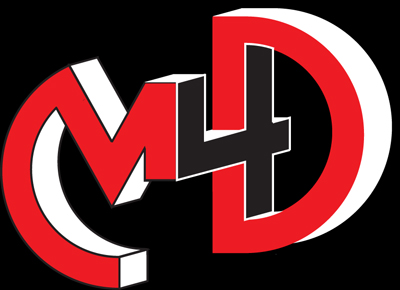CVT (Continuous Variable Transmission)
- Introduction
In theory, Continuous Variable Transmission is an ideal design - it varies the transmission ratio continuously so that you can say it is an automatic transmission with infinite no. of ratios. As a result, at any time the most suitable ratio can be chosen so that performance and energy efficiency are both optimized.
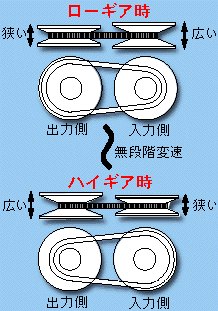 The theory of CVT is very simple. You might simply understand it from the picture beside.
The theory of CVT is very simple. You might simply understand it from the picture beside.
The core of CVT consists of a driving belt running between two pulleys, one connect to the engine output and one to the drive shaft. Each pulley comprises of 2 pieces of disc, with slope surface. When the discs are positioned far away from each other, the belt runs in an orbit with relatively small diameter, that equals to a small gear of conventional gearbox. When the discs are pushed towards together, the belt is pushed outside and runs in an orbit of large diameter, that equals to a big gear. As a result, the transmission ratio can be varied by pushing or easing the discs.
When one pulley is varied, the other pulley must adapt itself inversely since the length of the belt is fixed. This multiply the change of transmission ratio, too.
Difficulties
The theory is ideal, but implementation is difficult. As the belt is the highly stressed member, it must be very strong and grip very well on the pulleys. Most CVTs, including Honda Civic's, use a metallic belt developed by Netherlands' Van Doorne Transmissie BV. This belt consists of hundreds of transverse metal plates and longitude metal tapes. The transverse ones are used to grip the pulley, the longitude ones hold the transverse plates and deal with strain.
In the 80s, CVT failed to be popular because belts were not strong enough to handle the torque from larger engines. Therefore it was bounded to Ford Fiesta, Fiat Uno 60 Selecta and Subaru Justy, all of them had less than 1,300c.c. As the belt improved gradually, Honda introduced it into the 1600 c.c. Civic, then Nissan even applied it to the 2,000 c.c. class !
Hopefully in the next few years, CVT will invade 3,000 c.c. class. In then, I'm afraid many automatic makers will lose a big slice of market share.
CVT with manual override (eg. Nissan M6 Hyper-CVT)
 Nissan, accompany with its partner Subaru, is widely regarded as the leader in CVT technology, especially after it launched M6 Hyper-CVT in the Japanese Primera.
Nissan, accompany with its partner Subaru, is widely regarded as the leader in CVT technology, especially after it launched M6 Hyper-CVT in the Japanese Primera.M6 Hyper-CVT could be described as "the Tiptronic in the CVT world". Apart from fully auto mode like all CVTs, it provides a manual mode which simulates a 6-speed manual gearbox. Of course, in theory it can simulate more ratios, but no driver will ask for more than they can cope with.
Even if you ignore this trick, it was still the most advanced CVT of its time. Mated with Primera's 2-litre dohc VVT engine, M6 Hyper-CVT handles 190 hp and 150 lbft, a record of its time. It also delivers decent smoothness and response, thanks to the use of torque converter (like automatic transmission) instead of conventional electromagnetic clutch.
| Advantage: | Much cheaper, lighter and smaller than automatic. |
| Disadvantage: | In reality, no faster or more frugal than automatic. "Rubber band effect" ratio varying feels strange. Not really involving. Cannot cope with torquey engines. |
| Who use it ? | Nissan Teana, Primera, March, Cube (M6 Hyper-CVT), Fiat Punto (Speed Gear), Subaru Pleo (I-CVT), Rover MGF (Steptronic), Honda Fit.... many. |
Rubber band effect: when the accelerator pedal was pressed, conventional CVT immediately brings the rpm up to a high level. The engine put out its maximum performance with the corresponding level of noise but the car slowly catches up in acceleration. This gives one the feeling of a slipping clutch.
Audi Multitronic CVT
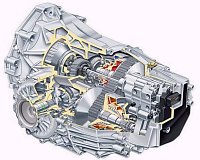
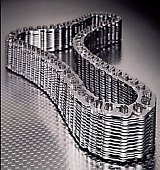
Theoretically, Continuous Variable Transmission should offer optimised fuel economy as well as acceleration. However, I have never seen such CVT ever appeared. All previous CVTs, no matter from Nissan, Subaru, Honda, Fiat or Ford, barely offers a smooth transmission. They might be cheap alternatives to automatic, but unable to match manual gearbox. Now Audi is claiming a real improvement based on the A6:
| A6 with 5-speed manual | ||
| A6 with 5-speed Tiptronic | ||
| A6 with Multitronic CVT |
The Multitronic differs from conventional CVT by two things :
1) it uses chain instead of belt as the media to transmit torque and vary gear ratio.
2) it has a torque sensor.
Most previous CVTs use a steel V-section belt invented by Dutch CVT specialist Van Doorne. How much torque the CVT withstand depends on the design of belt, which at its best (Nissan Primera) is 150 lbft. Instead, Audi developed a chain to replace the belt. The steel chain consists of 1025 link plates and 75 pairs of pins. It is almost as flexible as the V-section belt but much stronger. Therefore it can handle up to 221 lbft of torque.
Another breakthrough is the use of torque sensor. It ensures the pulleys clamp the chain with sufficient contact pressure but not excessive. Conventional CVTs always apply excessive pressure in order to cover all the possible conditions of use. Excessive pressure result in worsen fuel efficiency and wear. Fuel economy is further enhanced by the extra-wide gear ratio range - 6.05 : 1, compare with 5 : 1 of conventional manual gearbox.
The program is also cleverer. Firstly, it monitors engine speed to eliminate the "rubber band effect" which exists in previous CVTs. It ensures the engine rev increases with increasing driving speed. Secondly, from the pedal action, it recognizes whether the driver would prefer to drive in a more performance-oriented or consumption-oriented manner, hence choosing the right ratio. Lastly, it provides 6 sequential "manual" ratios for those who like more involvement. It enables engine braking as desired. Like Tiptronic S, there is an optional steering wheel control for upshift and downshift.
Most modern CVTs use electro-hydraulic clutch or torque converter, but Audi uses a multi-plate clutch, which is more complicated but enables smooth yet responsive transition.
| Advantage: | Cheaper and lighter than automatic; as quick and fuel efficient as manual box. |
| Disadvantage: | To be seen in road test. Torque capacity is still limited. Not for high performance cars. |
| Who use it ? | Audi Multironic |
Nissan Extroid CVT
 If Audi’s Multitronic is an evolution of the conventional CVT, Nissan’s Extroid is obviously a revolution. Instead of using a belt or chain as the media for varying transmission ratio, it uses two pairs of rollers. As shown in the picture, the rollers link between the input disc (which connects the crankshaft) and output disc (which connects the driveshaft). By varying the angle of rollers, different transmission ratio can be obtained. For example, for "low" gearing ratio, the rollers meet the input disc near its inside diameter, but meet the output disc near its periphery; thus the output disc turns much slower than the input disc. The overall ratio range is 4.4:1.
If Audi’s Multitronic is an evolution of the conventional CVT, Nissan’s Extroid is obviously a revolution. Instead of using a belt or chain as the media for varying transmission ratio, it uses two pairs of rollers. As shown in the picture, the rollers link between the input disc (which connects the crankshaft) and output disc (which connects the driveshaft). By varying the angle of rollers, different transmission ratio can be obtained. For example, for "low" gearing ratio, the rollers meet the input disc near its inside diameter, but meet the output disc near its periphery; thus the output disc turns much slower than the input disc. The overall ratio range is 4.4:1.Compare with belt or chain, the solid rollers can withstand much higher torque. Moreover, since the input and output disc are located at the same axis, it is able to be packaged in a longitudinal gearbox and drive the rear wheels. In fact, it is already driving the Cedric / Gloria in Japan, handling the massive 286 lbft of torque from the turbocharged VQ6.
- The rollers are actuated by electro-hydraulic. However, the rollers are not directly contact with the input / output disc. A specially developed viscous oil provides the traction between them while reduce friction and wearing.
Like other modern CVTs, it also provides 6 artificial sequential ratios for more driver involvement.
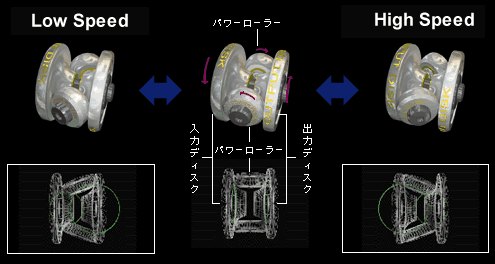
| Advantage: | Withstand high torque; smooth and refined. |
| Disadvantage: | Costly; no quicker than automatic; limited range of ratio. |
| Who use it ? | Nissan Cedric / Gloria, Skyline 350GT-8 |
